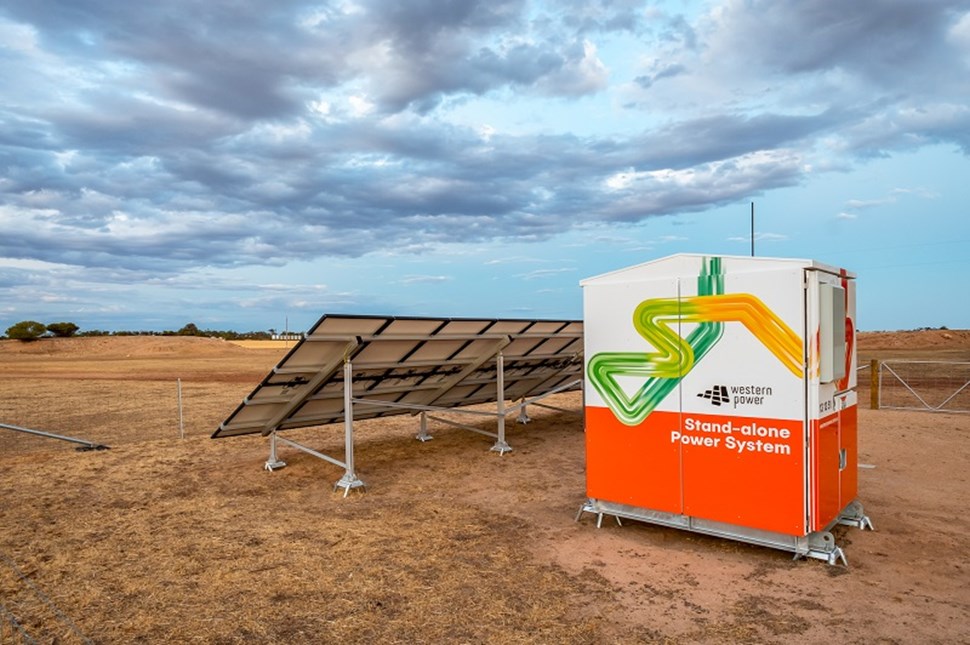When Ros and Berney Giles were asked if they wanted to take part in Western Power’s stand-alone power systems (SPS) trial to find alternative ways to power their 2000-hectare property, they were sceptical but curious.
Three years later, with a stand-alone power system now a permanent feature on their property and with power outages having dwindled to what Ros calls “the very occasional quick hiccups”, the Dunn Rock farmers are delighted they said yes.
“We’ve forgotten what power outages are,” says Ros.
“Being involved in this trial has been really positive for us and we are always talking to those in our area about how good it is to have a stand-alone power system.”
The Giles’s were one of six participants to take part in a three-year trial to test the viability of stand-alone power systems (SPS).
What is a stand-alone power system?
The SPS, which typically consist of a renewable energy source such as solar panels, a battery and a back-up generator, are designed to create a reliable power source on the property, reducing reliance on power from long stretches of powerlines.
“This has worked so well for us,” says Ros. “All our neighbours are watching with interest and asking how the trial was going. I can’t see why this wouldn’t work for others and give everyone, particularly in rural areas, better power supply.”

SPS - a game-changer in power quality and reliability for rural customers
SPS in the wide brown land
With the three-year trial in the Great Southern an unqualified success, SPS have become a practical alternative to the traditional poles and wires (or network assets) in regional Australia.
The Energy Network of Australia recently found that SPS are 15 times more reliable and safer poles and wires, so as well as providing better power supply, they also reduce bushfire risk.
“SPS are a no-brainer,” said Energy Networks Australia (ENA) CEO Andrew Dillon.
“There is clear evidence of significant potential benefits to customers associated with the deployment of these units. Stand-alone power systems have shown they can deliver cheaper and more reliable power to customers, especially in remote areas.”
With WA having a power network that spans an area bigger than the UK, and customers needing power in some of the most-remote locations in WA, regional customers are set to be one of the big winners from the SPS technology.
More than 50 per cent of the overhead distribution network in WA are dedicated to servicing around three per cent of the population. The distance and the size of the network makes maintaining it expensive in cost, resources and time.
It also means customers at the end of a line who experience a fault have become accustomed to having to wait until it can be fixed.
SPS can change all that.
“We’ve identified thousands of candidate sites in WA where we think customers could benefit from SPS over the next 30 years,” says Western Power’s SPS Program Manager, Margot Hammond.
“We have a clear plan of how we can use SPS to improve our future grid over the coming decades for many of our country customers. This is a very exciting time for us all.
“SPS has value for other customers as well, not just those in rural areas. As SPS takes the pressure off having to maintain poles and lines at the end of a spur, we expect to save many millions in infrastructure costs, which means WA taxpayers are saving in the long run.”
There is also the renewable energy aspect. Over the three years of the Great Southern trial the Giles’ took part in, the solar panels in the SPS were the source of more than 90 per cent of the total power used. This means the Giles farming property shifted its energy source to 90 per cent renewable.

What is next for SPS?
The State Government has introduced amendments to legislation which will support Western Power’s use of stand-alone power systems and energy storage devices.
A more extensive roll-out of SPS units is underway with around 52 units being installed on properties from Mullewa in the north to Elachbutting in the east and Wansborough in the south.
A further round of approximately 100 units has also been announced, with Western Power currently scouting for suitable properties, particularly those at the end of the line.
“As a technical alternative to poles and wires, SPS works really well. Finding ways to provide better energy solutions for our customers is of key importance to our business. Being able to do this through the use of renewable energy sources, saving taxpayers millions of dollars delivers a win for everyone.”
Want to find out more about SPS? Check out our FAQs for more info on what they are and how they work.

SPS have solar panels to create its own power and a battery for energy storage.
